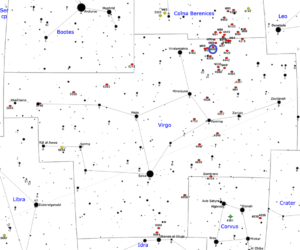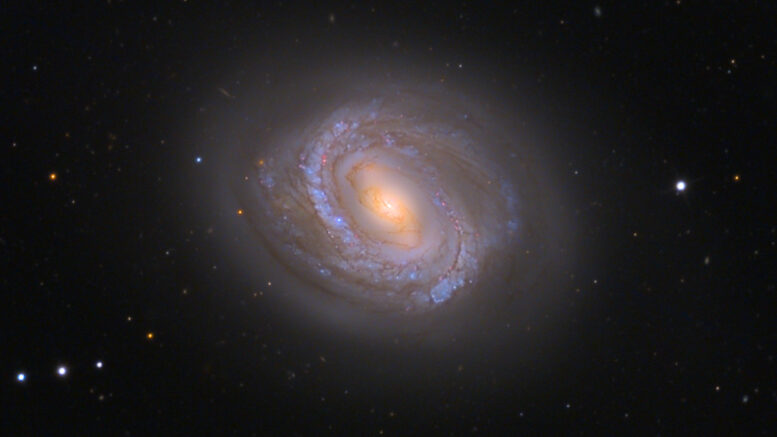Messier 58 was one of the first galaxies recognized to have a spiral shape and is one of four barred spiral galaxies in Messier’s entire catalog. A lack of hydrogen in the spiral galaxy and its arms means that there is very little star formation activity in the arms. This could be the result of gravitational interactions with the nearby galaxies of the Virgo cluster. Two supernovas have been detected in M58, one in 1988 and the other in 1989.
| Description | |
| Visible From Pacific Northwest | January to June |
| Best Time To Observe | March and April |
| Minimum Size Of Viewing Device | Small Telescope |
| Object Type | Barred Spiral Galaxy |
| Designations | Messier 58, M58, NGC 4579, PGC 42168, UGC 7796, GC 3121, VCC 1727, RX J1237.7+1149, IRAS 12351+1205 |
| Right Ascension | 12h 37m 43.5s |
| Declination | +11°49’05” |
| Constellation | Virgo |
| Number Of Stars | 400 billion |
| Apparent magnitude | +10.5 |
| Apparent dimensions | 5′.9 x 4′.7 |
| Object Radius | 58,000 light years |
| Distance From Earth | 62 million light years |
History
The galaxy was discovered by Charles Messier himself on April 15, 1779 and subsequently included in his catalogue as object number 58. It was the first barred spiral galaxy to be added to Messier’s list. Messier discovered it together with two elliptical galaxies located in the same area of the sky: Messier 59 and Messier 60. He described M58 as a “very faint nebula discovered in Virgo, almost on the same parallel as epsilon [Virginis], 3rd mag. The slightest light for illuminating the micrometer wires makes it disappear. M. Messier reported it on the chart of the Comet of 1779, which is located in the volume of the Academy for the same year.”
John Herschel catalogued the object as h 1368, describing it as “very bright; irregularly round; gradually brighter toward the middle; a bright star precedes [lies to the West] 1/2 field.” He later added it to the General Catalogue as GC 3121.
Messier 58 was one of the 14 “spiral nebulae” listed by Lord Rosse before 1850.
Locating M58 In The Sky
M58 can be located along the line from Vindemiatrix, Epsilon Virginis, to Denebola, Beta Leonis. About 4.5 degrees west and a bit north of Vindemiatrix lies the elliptical galaxy Messier 60. Messier 59, another bright elliptical, lies a bit further to the west.
Messier 58 can be found yet another degree to the west, slightly south of the line connecting Vindemiatrix and Denebola. The galaxy is located only about 2 degrees away from Rho Virginis, a white main sequence star with a visual magnitude of 4.9.

Viewing M58
In spite of its distance, M58 can be seen in large binoculars. In small telescopes, which only reveal the galaxy’s bright centre, M58 appears similar to elliptical galaxies found in the Virgo Cluster. 4-inch and larger telescopes show the galaxy’s halo, while 8-inch telescopes reveal a hint of the galaxy’s bar. The best time of year to observe M58 is during the spring.
Photographing M58
Messier 58 is a great galaxy to photograph! A tip for photographing this galaxy is to use different color wavelength filters during photography will help resolve the different dust into the appropriate colors. There isn’t necessarily a good guide online that is a 1 stop shop for imaging Messier 58, but using filters and finding an appropriate Astrobin photo using similar gear you have will help immensely.
Sources And Further Reading
Descriptions of all of Messier Objects can be found here.
https://www.nasa.gov/feature/goddard/2018/messier-58
https://freestarcharts.com/messier-58

Be the first to comment on "Messier 58"